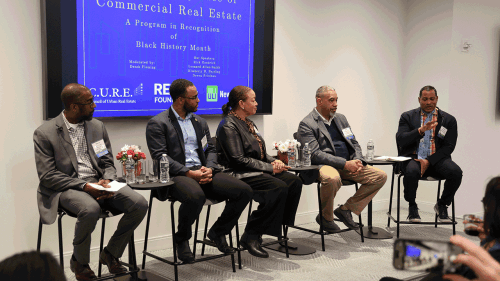This article appeared in the Fall issue of Urban Land on page 228.
In recent years, discussions about diversity and inclusion (D&I) have evolved from focusing on social preferences, values, fairness, and opportunity, to whether a business case for diversity can be made. Increasingly, studies done by researchers at leading academic institutions, research organizations, and consulting firms conclude that a business case for diversity exists—and it is a compelling one. In fact, the thrust of this growing body of research is that a statistically significant relationship exists between diversity and virtually every key aspect of organizational performance.
What is being discussed when we refer to diversity and inclusion? Diversity reflects the attributes that distinguish each of us and underscores our uniqueness as individuals. Diversity commonly is thought of in two fundamental dimensions: “inherent diversity,” also referred to as identity diversity, relates to our immutable, built-in traits and characteristics such as gender, race, ethnicity, disability, age, and sexual orientation. “Acquired diversity,” also known as cognitive and experiential diversity, involves our many different backgrounds and the sum of our learning, training, values, influences, experiences, and thinking styles.
In considering the value of D&I as an organizational strategy, it is useful to understand diversity as the degree of constructive difference within an organization. As a recent study commissioned by Deloitte explains, diversity is the “what.” It is the measure. And if diversity is the “what,” inclusion is the “how.” It is the method and the mind-set from which an approach to achieving D&I flows naturally. It is the way we go about creating a productively diverse organizational culture—one that maximizes the practical value of the heterogeneity that diversity reflects.
Inherent diversity and acquired diversity often overlap and can be mutually reinforcing, but they are not the same, nor is one necessarily a reliable proxy for the other. Each is valuable, but much more so when they are combined within a comprehensive D&I strategy. In fact, the emerging research reveals that diversity has the most profound impact on the broadest array of key performance indicators when companies’ inclusion strategies purposefully involve both dimensions of diversity, inherent and acquired. Furthermore, researchers at both McKinsey & Company and the Boston Consulting Group (BCG) insist that the positive effects of a well-formulated D&I strategy are most pronounced and more sustainable when D&I principles are part of—and aligned with—an organization’s broader strategy to grow the business and better serve its mission.
Diversity’s Impact on Performance
Groundbreaking research by Scott Page, professor of economics and complex systems at the University of Michigan, provides perhaps the most rigorous assessment of the impact of diversity on group performance to date. Page’s critically acclaimed book, The Difference: How the Power of Diversity Creates Better Groups, Firms, Schools, and Societies, published by Princeton University Press in 2007, lays out in painstaking detail how—by using advanced predictive models—he determined that cognitive diversity within teams is actually more important than expertise, and that diversity materially improves the speed and quality of decision-making and problem-solving, especially when decisions and problems are difficult, complex, and nonroutine (because routine favors expertise). Subsequent studies published by the Kellogg School of Management and Deloitte corroborate Page’s conclusions, affirmatively linking heterogeneity to better team performance, especially when teams include diverse participants who complement subject matter experts.
In addition to improved decision-making, the research arm of the Catalyst—a global nonprofit organization that conducts extensive research and advises senior corporate leaders on matters of diversity and inclusion, especially as they affect the experience of women in the workplace—comprehensively summarizes in its online blog much of the empirical research linking acquired diversity to better enterprise risk management, organizational agility, creativity, and innovation, as well as studies correlating inherent diversity with improved marketing outcomes, reputation and brand value, regulatory compliance, and success in competitive bidding processes, securing operating licenses, and acquiring talent. Researchers hypothesize that both forms of diversity play a demonstrably positive role in successful employee engagement and retention efforts, thus helping businesses maintain a competitive advantage in the market for human capital.
Of particular interest to most businesses are the voluminous study results showing a strong positive relationship between diversity and financial performance. This research, including two McKinsey studies involving more than 1,000 companies globally, correlate diversity (typically using inherent diversity indicators, including age, gender, and race, with profitability measured by the earnings before interest and taxes (EBIT) margin and long-term value-creation metrics (net operating profit less adjusted taxes—invested capital multiplied by weighted average cost of capital).
Other studies succinctly discussed in Catalyst and Medium.com’s Awaken blog have added to the list of non-GAAP (generally accepted accounting principles) financial performance metrics favorably influenced by D&I strategies. They include the following: earnings per share (EPS), including cumulative EPS growth; return on assets and equity; total shareholder return (TSR), i.e., dividends plus stock price accretion; gross and net margins; customer and revenue growth; market share; market capitalization; acquisition premiums; and valuation multiples. Generally, data from these studies are not sufficiently disaggregated to determine the relative contributions of inherent and acquired diversity to these operating results. However, the increased use of probative qualitative analytics is helping us better understand both the relative and aggregate value of all the relevant dimensions of D&I.
Personal and Institutional Preferences
While the volume of research supporting the business case for diversity continues to grow, personal and institutional preferences favoring diversity are becoming clearer and more pronounced. In the real estate context, cities—Boston and Philadelphia are two among many prominent examples—openly require, or at least favor, bids responding to their requests for proposal (RFPs) that include meaningful participation of diverse developers, contractors, and vendors, particularly minority- and women-owned business enterprises (M/WBEs). Beyond that, according to a recently commissioned ULI social-equity assessment, many developers report that in addition to winning development rights and securing project approval, considerations of diversity and inclusion continue throughout all phases of their work, from project vision and design, to the hiring of local contractors, and to producing outcomes that favorably affect underserved neighborhoods and communities close to the project.
Pressure on developers and other real estate professionals to deploy inclusive teams also comes from corporate clients who have come to expect—if not prefer—working with a diverse mix of professionals attuned to increasingly diverse (and diversity-conscious) customers, clients, stakeholders, and other interested parties capable of affecting project outcomes. TD Ameritrade’s Market Drive reports that this preference for inclusion is also reflected in recent marketing studies showing that millennial and generation Z consumer cohorts are strongly influenced by perceptions of diversity when making decisions about whom to buy from, rent from, work for, and otherwise do business with. Real estate development icon Jonathan Rose is perhaps most prescient in his belief that the strongest push for diversity is yet to come—and when it comes, it will be driven by the reality of generational and demographic shifts along with the resulting demands they place on the real estate industry. In discussing the real estate industry’s “diversity problem,” real estate magazine and website The Real Deal quotes Rose as saying, “You don’t negotiate [away] reality. Diversity is reality.”
Diversity research makes it clear that diversity matters for business. It also suggests how D&I principles can practically be applied in real-world situations and in ways that create value for a broad spectrum of stakeholders. In the real estate context, when properly done, D&I strategies can be accretive to the interests of many, from developers to neighboring communities affected by development projects.
Applying D&I Principles: The Omni Boston Seaport Hotel
For New Boston Hospitality, an entity affiliated with the Davis Companies, a 43-year-old Boston-based development company, diversity and inclusion are woven into virtually all aspects of its development of the Omni Boston Seaport Hotel project on Massachusetts Port Authority (MassPort) land in Boston’s thriving Seaport Waterfront District. The $550 million project includes development of a 1,050-room hotel and adjacent retail space. Diversity, inclusion, and community outreach were critical elements of Davis’s approach to winning the project initially and continue to be part of its execution strategy throughout all phases of construction and its aftermath.
Davis’s inclusion strategy for the project reflects two things that real estate professionals at the top of their game know. First, D&I and notions of social equity increasingly are part of their bread-and-butter business considerations. Second, effectively incorporating them as part of a sustainable growth strategy can create a competitive advantage, especially when tactics used to advance diversity help build operational capacity and fortify relationships with important partners and stakeholders for current and future undertakings.
Davis’s approach to D&I—while inspired and well meaning—is also carefully aligned with its strategic business objectives, both immediate and long-term. They include the following:
- Securing the development rights in a highly competitive RFP bidding process;
- Recruiting capable partners—both contractors and vendors—with the experience, expertise, and resources necessary to complete their respective assignments on time and on budget;
- Recruiting and cultivating capable M/WBEs as partners on the Omni Hotel project as well as on future projects;
- Constructively engaging neighboring communities and community-based organizations;
- Proactively engaging key stakeholders, thought leaders, and influencers, including public officials, community leaders, the media, and unions;
- Recruiting and maintaining the trust of key investors and achieving meaningful minority equity participation in the project; and
- Growing a more diverse talent pool and recruiting pipeline for Davis specifically and for the commercial real estate sector more broadly, and contributing to the creation of a more inclusive and diverse commercial real estate development ecosystem.
Davis’s inclusion strategy closely mirrors its strategic objectives and aligns with the tactics used to achieve them. Davis first had to prevail in a highly competitive bidding process based on MassPort’s RFP. The RFP included an ambitious M/WBE participation goal of 17.9 percent, accounting for 25 percent of MassPort’s award determination.
A bedrock element of Davis’s inclusion strategy involved securing diverse talent for all stages of the project, from planning and operations to design, engineering, lighting, acoustics, and tech and security. It sought to surpass the RFP’s target, so rather than achieving the 17.9 percent RFP goal and stopping, the Davis design team instead secured commitments amounting to a 31 percent M/WBE participation rate. This gave Davis a significant competitive advantage in bidding on the RFP given the importance that MassPort placed on minority participation in the site’s development.
To advance its plan, the Davis team actively recruited M/WBE firms with the requisite complement of talent and resolve, along with a demonstrated willingness to work closely with experienced partners. Davis was careful to select M/WBE firms amenable to receiving feedback and coaching, while also developing expertise, building capacity, cultivating relationships, and effectively performing their contractual roles.
Davis then paired certain diverse firms with more experienced majority contractors, particularly those with rigorous training, coaching, and mentoring as part of their organizational DNA and operating ethos. This helped ensure the quality and timely completion of the work. It accelerated learning processes, allowing participating M/WBE partners to sharpen their operational chops and develop greater know-how and expertise in real time. These “guided collaborations” positively affected the current project, while also creating greater capacity and more opportunity for meaningful M/WBE participation in future projects. It also elevated the visibility and stature of the diverse firms, enhancing their ability to attract the talent necessary to expand, grow, and compete successfully for future work.
Another aspect of Davis’s strategy emanated from its expanded vision of inclusion, a vision that incorporated community outreach activities ranging from partnering with local unions to recruit and train local residents (especially those from vulnerable local neighborhoods) for permanent post-construction jobs in the hospitality and retail sectors, to identifying promising students for learning, mentoring, and internship opportunities, treating them as potential future talent for the real estate sector. This latter part of Davis’s strategy addresses directly the often-repeated commercial real estate industry lament about the paucity of minority candidates for employment within the sector.
These engagements are substantive, meaningful, visible, and compelling. Intentional or not, they may come to represent the industry’s more evolved understanding of—and deeper appreciation for—the impact that developments like the Omni Hotel project can have on diverse communities and their constituents, and the corresponding role that these communities may play in helping achieve successful outcomes for the project and businesses that eventually will operate from the premises. This outreach element within a larger inclusion strategy illustrates the extent to which large-scale commercial developments of this kind can help move the needle on inclusion and collaboration by engaging diverse neighborhoods and communities, facilitating their active participation, and in the process gaining their trust and the trust—and even gratitude—of key public officials.
This, too, can reassure investors, mitigating some—but not all—of their concerns about various social and political issues that can delay or outright derail the timely completion of a project like the Omni Hotel development. In this instance, Davis’s proactive, public-facing approach to affected communities likely contributed to achieving not only diverse minority participation in the development, but also financing it, since $7 million was raised from diverse minority investors through syndication. As much as anything, this shows that Davis effectively identified and located diversity’s sweet spot, using D&I not only as an ethical or regulatory imperative, but also to Davis’s advantage in the competition for talent, capital, and the approval of influencers, stakeholders, and decision-makers. Ultimately, its D&I strategy was a central feature of its win.




